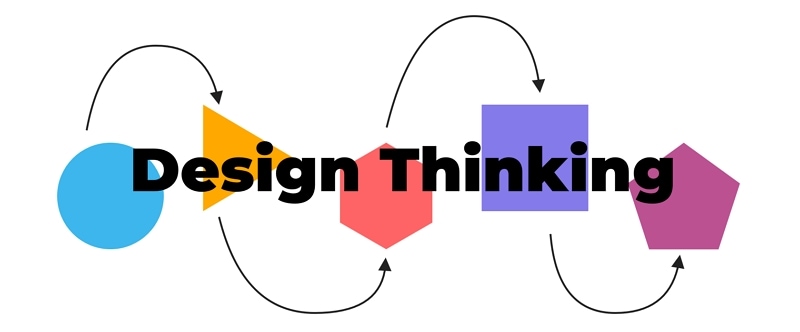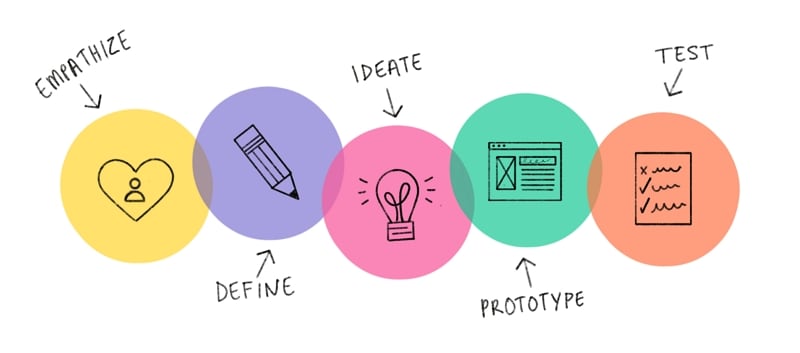Design thinking for Better UX

Design thinking is an ideology introduced by the Noble prize winner Herbert Simon in his book, Sciences of the Artificial in 1969. In simple words, it is thinking outside the box or changing the way of thinking to find out the solutions of problems. In his book Herbert stated the link of design thinking to an improved future.
This philosophy helps us to create innovative solutions logically with the help of five steps. So, in this article, we will discuss five stages of the design thinking process. Its relationship with UX design and its purpose, and why should UX designers invest time in design thinking?
Solution-Based Thinking of Designer

Design thinking is part of all companies regardless of their sector as it is an iterative, non-linear, and user-centric process. So, it enables the designers to come up with solution-based thinking instead of problem-based.
It is a framework for UX designers, and they use it as tools to solve problems. This solution-based thinking makes the designers to come up with extraordinary innovations that are out of boundaries.
Design thinking process has five steps named as Empathy, Define, Ideate, Prototype and Testing. Designers logically use these steps and repeat them to come up with a user-centric solution to the problem.
The Five Phases of Design Thinking

Empathize
The starting point for the design thinking process is empathy to focus on the needs of the users. At this stage, you put yourself in the users shoes to gain insight into user and their needs. You need to understand the life routine of the people, their needs, and thinking etc. The best way is to conduct interviews and surveys.
The rule of thumb at this stage is to avoid the assumptions regarding user’s needs. And your focus should be on the information from the interviews and surveys. It can be difficult to avoid assumptions, but you must do this for a good UX design, as presumptions can lead to useless products.
As we discussed earlier, it is a difficult step, and you can’t conclude the needs based on one or two interviews, so you should repeat this step to get a useful solution to the problem.
Define
At this step, you define a real problem based on the information from the first step of design thinking and makes a problem statement.
In this step too, your focus must adhere to users’ needs and to define the problem statement. Do not think about the product or organization at this stage. You will probably come back to this step after prototyping and testing to refine your problem statement.
The best tip here is not to hesitate to refine your statement and never assume it perfect. It is better coming back to this step to refine rather than facing the failure of the product.
Ideate
It is the third stage, after understanding user needs and problem statement. Here you will start working to think outside the box. It is the stage of creativity and brainstorming. You can use many ideation techniques like brainstorming, mind mapping, and role-play scenarios to formulate as many ideas as possible.
Do not think whether these ideas are feasible or not. After this, you will narrow down your ideas to move forward. You can start working on these ideas to come up with the final product. There is no need to decide only on one plan to work at this stage.
Prototype
The fourth stage of the designing process is all about experimentation and converting your ideas into tangible products. As you work on different ideas at this step, so plan your expenses at initial stages. You will have to discard most of the prototypes in the end.
It is the most crucial stage as you work on your ideas and try to make sure that nothing misses in the final design. UX designers use a professional prototyping tool to have a realistic view of the final product.
A prototype can fail so instead of worrying about it, work on it again, as a failed prototype is better than the failure of the actual product.
Test
It is the final stage of design thinking to test your prototypes on users and to ensure whether it is a feasible solution or not.
But this is not the end of the design thinking process. You will redefine your problem statement after from the insights to get a feasible plan to the problem.
It is your opportunity to validate your prototype so instead of explaining the design to users, give them and let them understand at their own. It’ll help you to refine the problem statement.
The purpose of Design Thinking for UX?

UX designers must invest some time and effort to learn about the design thinking process as it is challenging to understand the people for whom we are providing the solutions, and you can’t take risk to lose sight of the real problem.
It is strictly a user-centric process and pushes you to see the things as a user. At this stage, you only think about the real problems and don’t count in the product.
Design thinking focuses on finding solutions while UX design helps us to design theses solution. A good UX designs includes three main attributes, usefulness, usability and desirability.
The purpose of design thinking for UX is that it enables the designers to create revolutionary innovations. The steps involved in the thinking process makes the designers to learn fast, and iterate at any stage to refine the solution. So, it reduces the risks associated with new ideas and products.
The benefits of Design Thinking at work

The best thing about design thinking is that it is not a linear model, so you are not bound to follow a straightforward process. And you can come again to a certain point to refine your idea or problem to identify the issues and downfalls in the product design.
All businesses run on a list of never-ending goals and launching of new products. The new product formation can take enormous costs and if it fails, a loss. So, design thinking saves you from loses, as it focuses on the solution of the problem that people need. Immediate cost savings are a part of the ROI of design thinking, and the product is beneficial not only for the people but also for the company as
- It increases conversion rates
- Improves customer retention and loyalty
- Decreases customer support cost
Wrap Up
Design thinking is the way for UX designers to create innovations as it enables them to fit in the users shoes. And its five steps help them to focus on real problems. The non-linear and iterative nature of the process enhances your creativity and your thinking. And as a result, designers can see their creativity in action and meet their business goals and user needs.

